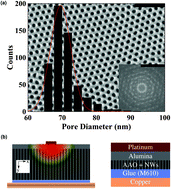Nanowire forest of pnictogen–chalcogenide alloys for thermoelectricity†
Abstract
Pnictogen and chalcogenide compounds have been seen as high-potential materials for efficient thermoelectric conversion over the past few decades. It is also known that with nanostructuration, the physical properties of these pnictogen–chalcogenide compounds can be further enhanced towards a more efficient heat conversion. Here, we report the reduced thermal conductivity of a large ensemble of Bi2Te3 alloy nanowires (70 nm in diameter) with selenium for n-type and antimony for p-type (Bi2Te3−ySey and Bi2−xSbxTe3 respectively). The nanowire growth was carried out through electrodeposition in nanoporous aluminium oxide templates with high aspect ratios leading to a forest (109 per centimetre square) of nearly identical nanowires. The temperature dependence of thermal conductivity for the nanowire ensembles was acquired through a highly sensitive 3ω measurement technique. The change in the thermal conductivity of nanowires is largely affected by the roughness in addition to the size effect due to enhanced boundary scattering. The major factor that influences the thermal conductivity was found to be the ratio of the rms roughness to the correlation length of the nanowire. With a high Seebeck coefficient and electrical conductivity at room temperature, the overall thermoelectric figure of merit ZT allows the consideration of such forests of nanowires as efficient potential building blocks of future TE devices.



 Please wait while we load your content...
Please wait while we load your content...